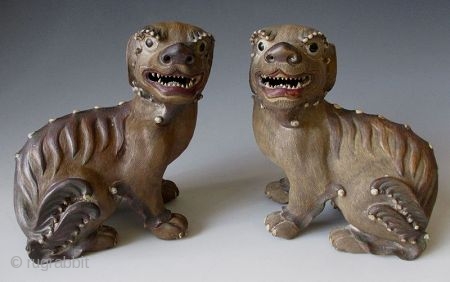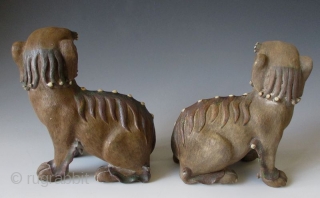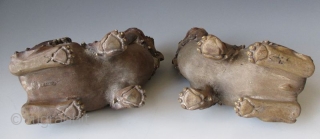Back
Pair of Chinese Antique Shiwan wear Fu-dogs
Antique Chinese pair of fu-dog (or fu-lions) hand made of Shiwan stonewear ceramic. Shiwan ware (Chinese: 石灣窯; pinyin: Shíwān yáo; Cantonese Jyutping: is Chinese pottery from kilns located in the Shiwanzhen Subdistrict of the provincial city of Foshan, near Guangzhou, Guangdong. It forms part of a larger group of wares from the coastal region known collectively as "Canton stonewares".
The area has been producing pottery since the Neolithic, and over 100 kiln-sites have now been excavated, but large-scale production of a variety of wares began under the late Ming dynasty, and continues to the present. Shiwan wares provide a contrast with more conservatively rendered Dehua efforts. Clay for the ware was provided not only from the local area, but also from distant locations that could be mixed to provide a variety of textures and desired ceramic outcomes.
The range could extend from a porcelain, rivalling Dehua in purity, to a rough stoneware. Shiwan ware was widely exported. Its glazing techniques directly influenced Japanese Shiga wares and others. Details of swirling mane, teeth, and claws are highlighted with white glaze. Finely incised fur overall.
Circa Early 1900's
Dimensions: 7" high x 6" wide
Antique Chinese pair of fu-dog (or fu-lions) hand made of Shiwan stonewear ceramic. Shiwan ware (Chinese: 石灣窯; pinyin: Shíwān yáo; Cantonese Jyutping: is Chinese pottery from kilns located in the Shiwanzhen Subdistrict of the provincial city of Foshan, near Guangzhou, Guangdong. It forms part of a larger group of wares from the coastal region known collectively as "Canton stonewares".
The area has been producing pottery since the Neolithic, and over 100 kiln-sites have now been excavated, but large-scale production of a variety of wares began under the late Ming dynasty, and continues to the present. Shiwan wares provide a contrast with more conservatively rendered Dehua efforts. Clay for the ware was provided not only from the local area, but also from distant locations that could be mixed to provide a variety of textures and desired ceramic outcomes.
The range could extend from a porcelain, rivalling Dehua in purity, to a rough stoneware. Shiwan ware was widely exported. Its glazing techniques directly influenced Japanese Shiga wares and others. Details of swirling mane, teeth, and claws are highlighted with white glaze. Finely incised fur overall.
Circa Early 1900's
Dimensions: 7" high x 6" wide
price:
3500.00
- Home
- Antique Rugs by Region
- Category
- Profiles
- Post Items Free
- Albums
- Benaki Museum of Islamic Art
- Budapest: Ottoman Carpets
- Gulbenkian Museum
- Islamic Carpets. Brooklyn
- Islamic Textiles. Brooklyn
- Konya Museum: Rugs
- MKG, Hamburg
- MMA: Caucasian Carpets
- MMA: Mamluk Carpets
- MMA: Mughal Indian Carpets
- MMA: Ottoman Carpets
- MMA: Safavid Persian Carpets
- MMA: Turkmen Rugs
- McCoy Jones Kilims
- Ottoman textiles. Met
- Philadelphia Museum
- Rugs and Carpets: Berlin
- Seljuqs at the Met
- TIEM, Istanbul: Carpets
- V&A: Classical Carpets
- Vakiflar Carpets: Istanbul
- Baluch Rugs: Indianapolis
- Gallery Exhibitions
- Jaf an Exhibition
- Alberto Levi Gallery
- Andean Textile
- Christie's London: 2016
- Francesca Galloway
- HALI at 40
- ICOC Washington, DC 2018
- Jajims of the Shahsavan
- London Islamic Week April, 2018
- Mongolian Felts
- Navajo Rugs: JB Moore
- Persian Piled Weavings
- SF Tribal & Textile Art Show 2020
- SF Tribal 2019
- Sotheby's: C. Alexander
- Turkish Prayer Rugs
- Turkmen Main Carpets ICOC 2007














